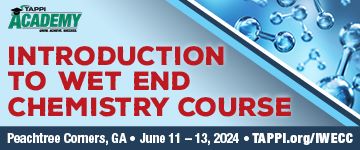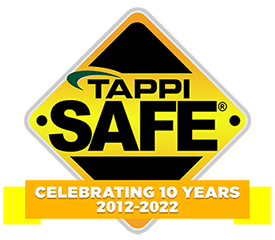 Search
Search
Use the search bar or filters below to find any TAPPI product or publication.
Filters
Content Type
Publications
Level of Knowledge
Collections
Magazine articles

Industry leaders: jukka harmala leads stora enso into new global age, TAPPI JOURNAL, May 2000, Vol. 83(5)
Industry leaders: jukka harmala leads stora enso into new global age, TAPPI JOURNAL, May 2000, Vol. 83(5)
Magazine articles

Using climate change policies for u.s. pulp and paper industry efficiency, TAPPI JOURNAL, July 2000, Vol. 83(7)
Using climate change policies for u.s. pulp and paper industry efficiency, TAPPI JOURNAL, July 2000, Vol. 83(7)
Journal articles

Magazine articles

Kraft pulp bleaching with a P-stage catalyzed by both bicarbonate and TAED, TAPPI Journal July 2019
ABSTRACT: Peroxide bleaching of softwood and hardwood (eucalypt) kraft pulps was performed in solutions of sodium bicarbonate (NaHCO3), sodium carbonate (Na2CO3), and sodium hydroxide (NaOH). The conventional P stage (hydrogen peroxide + sodium hydroxide; H2O2 + NaOH) was the most effective brightening system without an additional activator. However, peroxide activation by bicarbonate anion (HCO3•) was obvious in all cases where NaHCO3 or Na2CO3 was used. When N,N,N’,N’-tetraacetylethylenediamine (TAED) was added to the bleaching sys-tem, Na2CO3 as the alkali source afforded equal or slightly higher bleached brightness compared to NaOH usage for both the softwood and hardwood pulps. This outcome is attributed to simultaneous peroxide activation by HCO3• and TAED. When applied to the eucalypt pulp, the H2O2/Na2CO3/TAED bleaching system also decreased the bright-ness loss due to thermal reversion.
Journal articles

Magazine articles

Control of malodorous gases emission from wet-end white water with hydrogen peroxide, TAPPI Journal October 2021
ABSTRACT: White water is highly recycled in the papermaking process so that its quality is easily deteriorated, thus producing lots of malodorous gases that are extremely harmful to human health and the environment. In this paper, the effect of hydrogen peroxide (H2O2) on the control of malodorous gases released from white water was investigated. The results showed that the released amount of total volatile organic compounds (TVOC) decreased gradually with the increase of H2O2 dosage. Specifically, the TVOC emission reached the minimum as the H2O2 dosage was 1.5 mmol/L, and meanwhile, the hydrogen sulfide (H2S) and ammonia (NH3) were almost completely removed. It was also found that pH had little effect on the release of TVOC as H2O2 was added, but it evidently affect-ed the release of H2S and NH3. When the pH value of the white water was changed to 4.0 or 9.0, the emission of TVOC decreased slightly, while both H2S and NH3 were completely removed in both cases. The ferrous ions (Fe2+) and the copper ions (Cu2+) were found to promote the generation of hydroxyl radicals (HO•) out of H2O2, enhancing its inhibition on the release of malodorous gases from white water. The Fe2+/H2O2 system and Cu2+/H2O2 system exhibited similar efficiency in inhibiting the TVOC releasing, whereas the Cu2+/H2O2 system showed better perfor-mance in removing H2S and NH3.
Journal articles

Magazine articles

Production of antimicrobial paper using nanosilver, nanocellulose, and chitosan from a coronavirus perspective, TAPPI Journal July 2021
ABSTRACT: The pulp and paper industry has an opportunity to play a vital role in breaking the spread of the COVID-19 pandemic through production that supports widespread use of antimicrobial paper. This paper provides a brief review of paper and paper-related industries, such as those producing relevant additives, and R&D organizations that are actively engaged in developing antimicrobial papers. The focus here is on the potential of three nano-additives for use in production of antimicrobial papers that combat coronavirus: nanosilver, nanocellulose, and chitosan. Various recent developments in relevant areas and concepts underlining the fight against coronavirus are also covered, as are related terms and concepts.
Magazine articles

Energy: recovering capital and cutting costs, TAPPI JOURNAL, November 2000, Vol. 83(11)
Energy: recovering capital and cutting costs, TAPPI JOURNAL, November 2000, Vol. 83(11)
Journal articles

Magazine articles

Development of converging-diverging multi-jet nozzles for molten smelt shattering in kraft recovery boilers, TAPPI Journal March 2021
ABSTRACT: The effective shattering of molten smelt is highly desired in recovery boiler systems. Ideally, shatter jet nozzle designs should: i) generate high shattering energy; ii) create a wide coverage; and iii) minimize steam consumption. This study proposes a novel converging-diverging multi-jet nozzle design to achieve these goals. A laboratory setup was established, and the nozzle performance was evaluated by generating jet pressure profiles from the measurement of a pitot tube array. The results show that the shatter jet strength is greater with a large throat diameter, high inlet pressure, and a short distance between the nozzle exit and impingement position. Increasing the number of orifices generates a wider jet coverage, and the distance between the orifices should be limited to avoid the formation of a low-pressure region between the orifices. The study also demonstrates that an optimized converging-diverging multi-jet nozzle significantly outperformed a conventional shatter jet nozzle by achieving higher energy and wider coverage while consuming less steam.
Magazine articles

Factors affecting the fabrication of corrosion barriers for rp equipment in bleaching environments, TAPPI JOURNAL, September 1995, Vol. 78(9)
Factors affecting the fabrication of corrosion barriers for rp equipment in bleaching environments, TAPPI JOURNAL, September 1995, Vol. 78(9)
Magazine articles

Chemical recovery conference emphasizes high solids firing and mill system closure, TAPPI JOURNAL, August 1995, Vol. 78(8)
Chemical recovery conference emphasizes high solids firing and mill system closure, TAPPI JOURNAL, August 1995, Vol. 78(8)
Magazine articles

Conversion from acid to alkaline with a film transfer size press, TAPPI JOURNAL, June 1991, Vol. 74(6)
Conversion from acid to alkaline with a film transfer size press, TAPPI JOURNAL, June 1991, Vol. 74(6)






